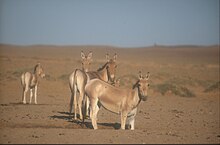蒙古野驢
外观
| 蒙古野驢 | |
|---|---|

| |
| 科学分类 | |
| 界: | 动物界 Animalia |
| 门: | 脊索动物门 Chordata |
| 纲: | 哺乳纲 Mammalia |
| 目: | 奇蹄目 Perissodactyla |
| 科: | 马科 Equidae |
| 属: | 马属 Equus |
| 种: | 亞洲野驢 E. hemionus
|
| 亚种: | 蒙古野驢 E. h. hemionus
|
| 三名法 | |
| Equus hemionus hemionus Pallas, 1775
| |
| 異名 | |
|
Equus hemonius luteus | |
蒙古野驢(Equus hemionus hemionus,蒙古语:ᠬᠤᠯᠠᠨ,西里尔字母:хулан),或稱戈壁野驢,是亞洲野驢的一個亞種。[2]牠們分佈在蒙古及中國北方,以往亦曾在哈薩克出沒,但因獵殺而在當地滅絕了。[3]
蒙古野驢的分佈地於1990年代大大的減少。於1994年至1997年估計就有33000-63000隻蒙古野驢,分佈在差不多整個蒙古南部。[4]但到了2003年就只有約20000隻,分佈在蒙古南部的17萬平方公里。[5]雖然所有資料都非正式統計[6][7],但肯定牠們在過去70年就已失去了50%的分佈地。
蒙古野驢的數量下降是因被烹吃及與其他家畜爭食所致,並被列為瀕危物種。[1]自1953年起,牠們在蒙古就已經全面受到保護。牠們被列在《瀕危野生動植物種國際貿易公約》附錄二中。[8]但是,由於人類人口膨漲及嚴冬的氣候[9],牠們與牧民之間的爭競就更為激烈。
蒙古野驢被烹吃的問題日益嚴重。在一些地區,牠們的肉是很廉價。單於2005年的問卷調查,就顯示每年有多達4500匹蒙古野驢被烹吃,即總數量的20%。再者於1990年代初,政策容許城市居民回歸為遊牧民族,引發野外地區的人口及家畜暴增。[10][11][12]
參考
[编辑]- ^ 1.0 1.1 Kaczensky, P., Lkhagvasuren, B., Pereladova, O., Hemami, M. & Bouskila, A. Equus hemionus ssp. hemionus. The IUCN Red List of Threatened Species 2015. [2018年7月19日].
- ^ Oakenfull EA, Lim HN and Ryder AO. A survey of equid mitochondrial DNA: Implications for the evolution, genetic diversity and conservation of Equus. Cons Genet. 2000, 1: 341–355.
- ^ Clark, B. and Duncan, P. Asian Wild Asses - Hemiones and Kiangs (E. hemionus Pallas and E. kiang Moorcroft). P. Duncan (ed.) (编). Zebras, Asses, and Horses. An Action Plan for the Conservation of Wild Equids. IUCN, Gland, Switzerland: IUCN/SSC Equid Specialist Group. 1992: 17–21.
- ^ Reading, R. P., H. M. Mix, B. Lhagvasuren, C. Feh, D. P. Kane, S. Dulamtseren, and S. Enkhbold. Status and distribution of khulan (Equus hemionus) in Mongolia. Journal of Zoology, London. 2001, 254: 381–389.
- ^ Mongolian Ministry of Nature and Environment. Status and distribution of the khulan in Mongolia in 2003. Mongolian Ministry of Nature and Environment, Ulaanbaatar, Mongolia. 2003.
- ^ Buckland, S.T., D.R. Anderson, K.P. Burnham, J.L. Laake, D.L. Borchers and L. Thomas. Introduction to Distance Sampling. Oxford UK and New York USA: Oxford University Press. 2001: 432.
- ^ Kaczensky P. and C. Walzer. Przewalski horses, wolves and khulans in Mongolia. Bi-annual progress reports. 2002a, 2002b, 2003a, 2003b [2022-07-19]. (原始内容存档于2012-12-01).
- ^ CMS 2002. Convention on Migratory Species. Appendix II. 互联网档案馆的存檔,存档日期2006-05-13.
- ^ United Nations Disaster Management Team (UNDMT): National Civil Defence and State Emergency Commission Ulaanbaatar. DZUD 2000-Mongolia: An evolving ecological, social and economic disaster: A rapid needs assessment report. United Nations Disaster Management Team (UNDMT): National Civil Defence and State Emergency Commission Ulaanbaatar. 2000.
- ^ Fernandez-Gimenez, M. E. Sustaining the Steppes: A Geographical History of Pastoral Land Use in Mongolia. Geographical Revue. 1999, 89 (3): 315–342.
- ^ Bedunah, D. J. and S. M. Schmidt. Pastoralism and protected area management in Mongolia's Gobi Gurvansaikhan National Park. Development and Change. 2004, 35 (1): 167–191.
- ^ Mearns, R., D. Shombodon, G. Narangerel, U. Tuul, A. Enkhamgalan, B. Myagmarzhav, A. Bayanjargal, and B. Bekhsuren. Natural resource mapping and seasonal variations and stresses in Mongolia. RRA Notes. 1994, 20: 95–105.

